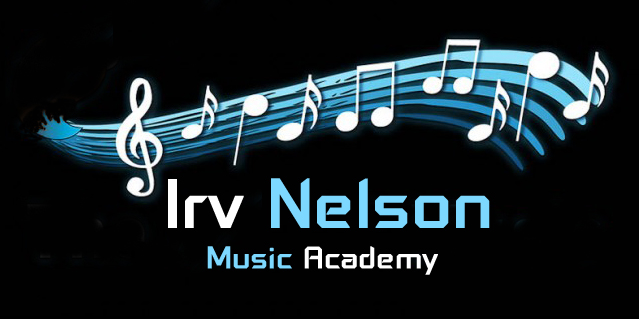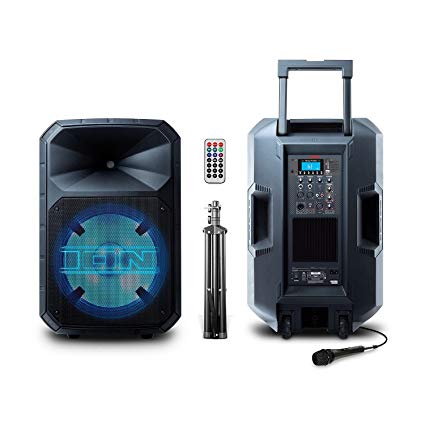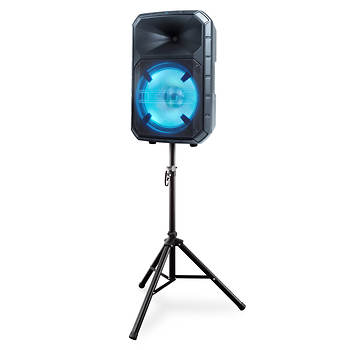
Contemporary Music Instruction and Mentoring
Selecting an All-In-One PA System
Anyone who wants to perform in public needs some kind of a PA system. Vocalists cannot rely on whatever PA system the venue has, if they have one at all. Pianists who haul a digital keyboard around cannot rely on the tiny built-in speakers that are not loud enough for live performance. Acoustic guitarists cannot use a "guitar amp" that is made for electric guitar. Acoustic guitars, electronic pianos, and vocals all need a PA system that amplifies the sound cleanly without changing it in any way except to be louder.
The components of a traditional PA system are:
Microphone (and mic stand with mic clip)
Mic cord (and guitar or keyboard cord)
Mixer
Mixer to Amplifier cord
Amplifier
Amplifier to speaker cabinet cord
Speaker cabinet (and speaker stand)
Power cords for mixer and amplifier, plus power strip and
extension cords
Optional:
Monitor (and amplifier and cords for the monitor)
Microphones are discussed in a separate article
(LINK HERE).
Mixers are discussed in a separate article (LINK
HERE).
Mixers and amplifiers used to always be separate
components. In large
professional PA systems, they still are. But
in the last decade a new type of amplifier has has shrunk
the size and reduced the weight of amps to the point where
they are now very small and very light. (These amps
are called "Class D" type if you're
interested in technical jargon.) This has
made it possible to build the amplifier and the mixer right
into a speaker cabinet. For solo musicians, duets, and
acoustic bands, this is the way to go. These
all-in-one systems are faster to set up, have fewer cords to
mess with, and fewer components to haul around, set up, take
down, and store at home. They have sufficient power
for all solo and small group gigs indoors, and many outdoors
gigs too, depending on the size of the crowd. They are
NOT powerful enough for a band, especially outdoors.
There are many all-in-one systems out there, at
various price and quality points. I will focus on the
two that I think are the best values.
The easiest to use and best sounding all-in-one
systems are called "line array" or "column array"
systems. Bose invented these, and I have owned a Bose
L1 for quite a few years now. It is fantastic because
it is excellent sounding, and it disperses sound nearly 180
degrees, so it does not feed back badly when placed behind
the performers and thus it can be the main and the monitor
all in one. The latest version is the Bose L1 Pro 8
(below left), and it is a fantastic system... BUT
Another company has recently upped the game on Bose. The best line array speaker available now in the $1,000-$1,500 price range may be the ElectroVoice Evolve30M (below right). It has more power than the Bose, a bigger subwoofer, more channels on the mixer, iPad or iPhone control of the mixer, effects on the mixer, and a host of other features, all at a price point comparable to the Bose (about $1,300). Also, it projects the sound a longer distance than the Bose. I have used both, and I like the Bose better in small, intimate venues. It is lighter and easier to haul, and it disperses the sound nearly 180 degrees sideways so that people (and performers) don't have to be right in front of the speaker to hear. But for a medium to large sized venue, the Electrovoice kicks the Bose's butt. It sounds absolutely fantastic, crisper, cleaner, more bass, it projects to the back of the hall far better (just as loud and clean in the back as in the front), and it can be really loud (123db is the spec!)


As I already mentioned, the only potentially bad
thing about the EV is it does not disperse sound quite as
widely as the Bose (120 degrees rather than 180 degrees with
the Bose). So performers on the edges of a wide stage
won't be able to hear it as well as performers in the
middle. And feedback is a little more of a problem
when it is placed behind the performers. Also, it's a
little heavier than the Bose because the subwoofer is bigger
and the case is plywood instead of plastic. But at
44lbs total (the base is 35lbs), it's not horribly heavy.
The other option I recommend that is the best
buy in the lowest price range is the Ion Total PA series
(Total PA Pro, Total PA Max, Total PA Prime, Total PA Glow,
Total PA Premier, etc.) that is sold at Sam's Club. It
can sometimes also be found on Amazon, but it's cheaper at
Sam's, and replacement or refund if there is a problem is
much simpler at Sam's. These speakers are bigger and
bulkier than line array speakers, but they have 500 Watts,
15" subwoofers, a two channel mixer, a tripod, all-plastic
cases, caster wheels, and an airport style handle. At
just over $200 each, these speakers are an absolute
BARGAIN. This is the system I recommend to all
students who can't afford a line array system yet.


I use my ION's as mains for acoustic gigs where my Bose isn't big enough, and as monitors in my rock band (where we have a 4,000 Watt professional mains system). In both cases, the IONs perform very well. The bass response is so good you could use it as a medium sized bass guitar amp (or as an electronic drum monitor or keyboard amp) for less than 1/4 the price of a 500W bass guitar amp and cabinet. In small and medium sized venues you can use one as a monitor and one as a main. In larger venues you can point them both at the audience and have a 1,000 Watt system. They can even be used for a band. (If every member of a 5 piece band buys one, you'll have four mains (2,000 Watts) plus one monitor for $1,000 total.) It's nowhere near as good as a pro system, but it's better than anything else at that price.
The only downsides of this system are that
the cabinet is bulky and a little heavy, the treble
driver is a piezo that doesn't have much midrange punch,
and the case is made of a type of Chinese plastic that
releases stinky plastic-smelling fumes for a long time
(it took 2 years before I could stand having mine in the
house.) The mixer is just OK; it has two
mic/guitar inputs plus an auxiliary input, treble and
bass for the overall mix (not for each channel), and
reverb for the overall mix (not for each channel).
But this system, even without the speaker stands, is
probably worth more than $600. It sells for 1/3
that amount. You can buy THREE of them for about
$650, which is HALF the price of a line array
system. I haven't heard about any reliability
problems. Mine seem rugged enough. I figure
even if one of them breaks, I can replace it with a new
one and I've still come out ahead financially. If
you are on a budget, I don't think you can go wrong with
the ION Total PA.